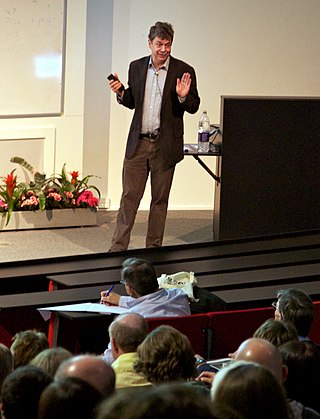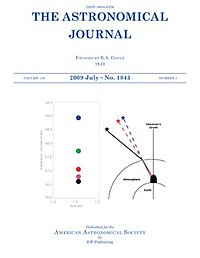The Astrophysical Journal (ApJ) is a peer-reviewed scientific journal of astrophysics and astronomy, established in 1895 by American astronomers George Ellery Hale and James Edward Keeler. The journal discontinued its print edition and became an electronic-only journal in 2015.

The American Astronomical Society is an American society of professional astronomers and other interested individuals, headquartered in Washington, DC. The primary objective of the AAS is to promote the advancement of astronomy and closely related branches of science, while the secondary purpose includes enhancing astronomy education and providing a political voice for its members through lobbying and grassroots activities. Its current mission is to enhance and share humanity's scientific understanding of the universe as a diverse and inclusive astronomical community.

Helen Battles Sawyer Hogg was an American-Canadian astronomer who pioneered research into globular clusters and variable stars. She was the first female president of several astronomical organizations and a scientist when many universities would not award scientific degrees to women. Her scientific advocacy and journalism included astronomy columns in the Toronto Star and the Journal of the Royal Astronomical Society of Canada. She was considered a "great scientist and a gracious person" over a career of sixty years.

The Astronomical Society of the Pacific (ASP) is an American scientific and educational organization, founded in San Francisco on February 7, 1889, immediately following the solar eclipse of January 1, 1889. Its name derives from its origins on the Pacific Coast, but today it has members all over the country and the world. It has the legal status of a nonprofit organization.
Jeremiah Paul "Jerry" Ostriker is an American astrophysicist and a professor of astronomy at Columbia University and is the Charles A. Young Professor Emeritus at Princeton, where he also continues as a senior research scholar. Ostriker has also served as a university administrator as Provost of Princeton University.
Dirk Brouwer was a Dutch-American astronomer.

Benjamin Apthorp Gould was a pioneering American astronomer. He is noted for creating the Astronomical Journal, discovering the Gould Belt, and for founding of the Argentine National Observatory and the Argentine National Weather Service.

Publications of the Astronomical Society of the Pacific is a monthly peer-reviewed scientific journal managed by the Astronomical Society of the Pacific. It publishes research and review papers, instrumentation papers and dissertation summaries in the fields of astronomy and astrophysics. Between 1999 and 2016 it was published by the University of Chicago Press and since 2016, it has been published by IOP Publishing. The current editor-in-chief is Jeff Mangum of the National Radio Astronomy Observatory.

Formed in 1954, the American Astronautical Society (AAS) is an independent scientific and technical group in the United States dedicated to the advancement of space science and space exploration. AAS supports NASA's Vision for Space Exploration and is a member of the Coalition for Space Exploration and the Space Exploration Alliance. The AAS also focuses on strengthening the global space program through cooperation with international space organizations. The society has a long history of supporting space exploration through scholarships.
Scott Duncan Tremaine is a Canadian-born astrophysicist. He is a fellow of the Royal Society of London, the Royal Society of Canada and the National Academy of Sciences. Tremaine is widely regarded as one of the world's leading astrophysicists for his contributions to the theory of Solar System and galactic dynamics. Tremaine is the namesake of asteroid 3806 Tremaine. He is credited with coining the name "Kuiper belt".

Astronomische Nachrichten, one of the first international journals in the field of astronomy, was established in 1821 by the German astronomer Heinrich Christian Schumacher. It claims to be the oldest astronomical journal in the world that is still being published. The publication today specializes in articles on solar physics, extragalactic astronomy, cosmology, geophysics, and instrumentation for these fields. All articles are subject to peer review.
Gerald Maurice Clemence was an American astronomer. Inspired by the life and work of Simon Newcomb, his career paralleled the huge advances in astronomy brought about by the advent of the electronic computer. Clemence did much to revive the prestige of the U.S. Nautical Almanac Office.

Simon David Manton White, FRS, is a British-German astrophysicist. He was one of directors at the Max Planck Institute for Astrophysics before his retirement in late 2019.
1919 Clemence, provisional designation 1971 SA, is a bright Hungaria asteroid and suspected tumbler from the inner regions of the asteroid belt, approximately 4 kilometers in diameter. It was discovered on 16 September 1971, by American astronomer James Gibson together with Argentine astronomer Carlos Cesco at the Yale-Columbia Southern Station at Leoncito Astronomical Complex in Argentina. It is named after astronomer Gerald Clemence.
IOP Publishing is the publishing company of the Institute of Physics. It provides publications through which scientific research is distributed worldwide, including journals, community websites, magazines, conference proceedings and books. The Institute of Physics is a scientific charity devoted to increasing the practice, understanding and application of physics. Any financial surplus earned by IOP Publishing goes to support physics through the activities of the Institute.

Wendy Laurel Freedman is a Canadian-American astronomer, best known for her measurement of the Hubble constant, and as director of the Carnegie Observatories in Pasadena, California, and Las Campanas, Chile. She is now the John & Marion Sullivan University Professor of Astronomy and Astrophysics at the University of Chicago. Her principal research interests are in observational cosmology, focusing on measuring both the current and past expansion rates of the universe, and on characterizing the nature of dark energy.
Takeshi Oka,, is a Japanese-American spectroscopist and astronomer specializing in the field of galactic astronomy, known as a pioneer of astrochemistry and the co-discoverer of interstellar trihydrogen cation . He is now R.A. Milliken Distinguished Service Emeritus Professor, Departments of Astronomy and Astrophysics, Chemistry; Enrico Fermi Institute; and the College of University of Chicago.
Edward M Sion is an American astrophysicist who is Professor in the Department of Astrophysics and Planetary Science at Villanova University. He specializes on the structure and evolution of white dwarf stars and white dwarf stars in explosive binary star systems known as cataclysmic variables.

Alice Hall Farnsworth was an American astronomer. She was director of John Payson Williston Observatory at Mount Holyoke College from 1936 until her retirement in 1957.
John Craig Wheeler is an American astronomer. He is the Samuel T. and Fern Yanagisawa Regents Professor of Astronomy Emeritus at the University of Texas at Austin. He is known for his theoretical work on supernovae. He is a past president of the American Astronomical Society, a Fellow of that society, and a Fellow of the American Physical Society.










